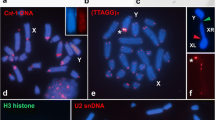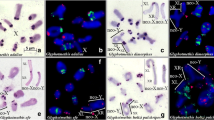Abstract
The grasshopper Oedaleonotus enigma possesses a neo-XY sex system and the rest of the chromosome complement is highly polymorphic, suggesting recent chromosomal evolution. It contains a fusion between two telocentrics, a centric shift and an extra heterochromatic segment, all of which are polymorphic, and in addition it has B-chromosomes. The fusion polymorphism has a preponderance of heterokaryotypes, and despite frequent inbreeding the other two polymorphisms have binomial frequencies of heterokaryotypes. Male individuals with two neo-X chromosomes and no neo-Y (at least in the germ line) are discussed.
Similar content being viewed by others
References
Cain, A. J., and P. M. Sheppard: Natural selection in Cepaea. Genetics 39, 89–116 (1954).
Dobzhansky, Th.: Genetics and the origin of species, 3rd edit. New York: Columbia University Press 1951.
Ford, E. B.: Genetic polymorphism. All souls studies, 5. London: Faber & Faber, 1965.
Hewitt, G. M.: A tetrasomic mosaic in the germ line of Chorthippus parallelus. Heredity 18, 505–512 (1963).
—: An interchange which raises chiasma frequency. Chromosoma (Berl.) 21, 285–295 (1967).
John, B., and G. M. Hewitt: A polymorphism for heterochromatic supernumerary segments in Chorthippus parallelus. Chromosoma (Berl.) 18, 254–271 (1966).
—: Patterns, pathways and processes of chromosomal evolution in the Orthoptera. Chromosoma (Berl.) 25, 40–74 (1968).
King, R. L.: Neo Y chromosome in Hypochlora alba and Mermiria intertexta (Orthoptera acrididae). J. Morph. 87, 227–257 (1950).
Lewis, K. R., and B. John: Chromosome marker, p. 69–82. London: Churchill 1963.
Lindsten, J.: The nature and origin of X chromosome aberrations in Turner's syndrome. Uppsala: Almquist & Wiksell 1963.
Procunier, D., and D. T. Suzuki: Interchromosomal effects on crossingover in Drosophila melanogaster, 4. All compound X chromosomes. Canad. J. Genet. Cytol. 9, 874–879 (1967).
Saez, F. A.: Gradient of heterochromatinisation in the evolution of the sexual system “neo X — neo Y”. Port. Acta biol. A 7, 111–138 (1963).
Schroeter, G. L.: Ph. D. Thesis, University of California (1968).
Thompson, R. M., and G. A. Buxton: An index of the Acridoidea (Orthoptera) of California. Bureau of Entomology, California Department of Agriculture, occasional papers no 5, 1–62 (1964).
White, M. J. D.: Animal cytology and evolution, 2nd edit. Cambridge: University Press 1954.
—, and P. H. W. Morley: Effects of pericentric rearrangements on recombination in grasshopper chromosomes. Genetics 40, 604–619 (1955).
Author information
Authors and Affiliations
Rights and permissions
About this article
Cite this article
Hewitt, G., Schroeter, G. Population cytology of Oedaleonotus . Chromosoma 25, 121–140 (1968). https://doi.org/10.1007/BF00327173
Received:
Issue Date:
DOI: https://doi.org/10.1007/BF00327173




